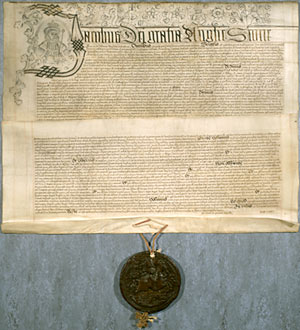Letters patent
Grants of land or rights from the monarch to a private individual were made by letters patent. These documents are very impressive, written on big sheets of parchment. They are often illuminated at the top with enormous initial letters, decorations, and a portrait of the King or Queen. The Great Seal was attached at the bottom of the deed.
Letters patent were also produced allowing owners of manors to sell them. These letters patent are sometimes called a 'Licence to Alienate'. Other grants from the monarch to private individuals, such as appointments to public office, or pardons, were also made by letters patent.
Letters patent were open to all people to see. Letters from the monarch addressed only to specific people were called 'letters close', because they were closed to all except the recipients.
Purpose
Record of the transfer or confirmation of something from the King or Queen to a private individual.
Features of letters patent
-
12th-19th centuries
- large size
- written on parchment
- written in Latin until 1733
- deed poll (straight top edge)
- impressive legal writing
- sometimes illuminated, with a portrait of the monarch in the top left corner
- Great Seal attached at the bottom
Important words and phrases
Letters patent will begin with the name of the monarch, and continue:
[Latin] Omnibus ad quos presentes litere pervenerint Salutem
[English]
To all those to whom these present letters shall come, greeting
The name of the grantee will be given, and a description of the lands involved.
Example
Ne D 3846 - Letters patent of James I (Latin) to Francis Manners, 6th Earl of Rutland for various properties in Nottingham, including Nottingham Castle; 18 Feb. 1623

View this deed
This letters patent is made from one full and one partial membrane of parchment, measuring 73 cm wide by 57 cm long. We know it is a letters patent because of the following characteristics:
- It is a deed poll, that is, the top of the deed is cut in a straight line. This indicates that the deed was made by just one person
- It is made by King James
- It is addressed 'to all to whom these present letters shall come'
- It includes a portrait of the King in the top-left corner
- It is sealed with the Great Seal of King James, made from black wax
Transcription and translation of the main parts of the deed
Parties [lines 1-3]
[Latin]
JACOBUS DEI GRATIA ANGLIE SCOCIE
Francie et Hibernie Rex fidei defensor &c Omnibus at quos presentes litere pervenerint Salutem Sciatis q[uo]d nos tam pro et consideracione boni veri fidelis et acceptabil'...
[English] James, by the grace of God King of England, Scotland,
France and Ireland, defender of the faith, etc. To all to whom these present letters shall come, Greetings. Know that as well for and in consideration of good true faithful and acceptable ...
In the middle of the third line, the name 'Franciscum Comitem Rutland' appears. This is the person to whom the grant is being made.
Operative Parts, or 'Testatum' [line 4]
[Latin]
Dedimus et concessimus
[English] We have given and conceded
In the middle of the fifth line, we see the word 'imperpetuum' [for ever].
Parcels [line 5 onwards]
[Latin]
Totum illud Castrum nostrum de Nottingham in comitatu nostro Nottingham ...
[English]
All of that our Castle of Nottingham in our county of Nottingham ...
The next few lines are taken up with a detailed description in Latin of all the property involved in this grant. It includes:
[English] Nottingham Castle with all outbuildings, barns, stables, yards, land, woods and so on; a close called Dovecote Close, with all buildings erected there; the park and enclosed lands known as Nottingham Park, with all woods, trees and so on; parcel of land in the Kings Meadows; a further parcel of meadow ground of approximately 60 acres in Nottingham, to the east and west part of the castle; parcel of pasture ground called Cow Close of approximately 6 acres between the said meadow ground and the castle; parcel of land called Hele Close of approximately 3 acres, near to Cow Close; a further close of about 3 acres lying upon the marsh ground; and finally a close called Roach Close of approximately 3 acres
Habendum
The clause detailing the terms of the grant, is hidden at the bottom of the first membrane, but reads as follows:
[Latin] Tenendum de nobis heredibus et successoribus nostris ut de manerio nostro de Eastgreenewich in Comitatu nostro Kantie per fidelitat tantum in libero et com[m]uni socagio et non in capite nec per servic' militare...
[English] To be held of us, our heirs and successors, as of our manor of East Greenwich in our county of Kent, by so much fidelity, in free and common socage, and not in capite or by knight's service
In other words, the earl was to be a freeholder of the manor of East Greenwich, but was not liable to perform any special services for the estate. However, there was a fee farm rent of thirty shillings which had to be paid annually to the King and his successors.
Attestation and dating
This clause comes at the end of the document:
[Latin] In cuius rei Testimonium has literas nostras fieri fecimus patentes. Teste me ipso apud Westmonasterium decimo octavo die Februari anno regni nostri Anglie Francie et Hibernie vicesimo et Scocie quinquagesimo sexto
[English] In witness of which thing we have made these our letters to be patent. Witnessed by myself at Westminster the 18th day of February in the 20th year of our reign of England, France and Ireland, and the 56th of Scotland
Next page: Bargain and sale